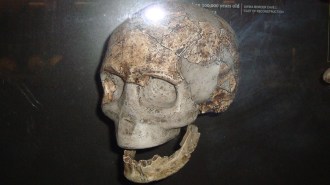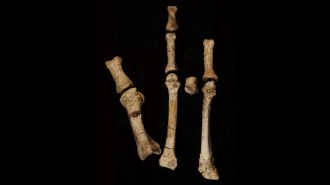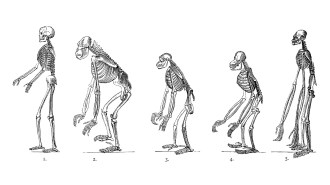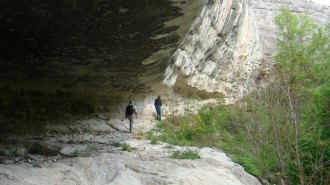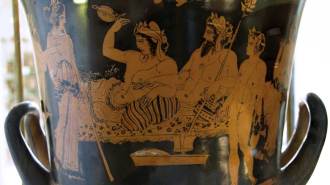Contested signs of mass cannibalism
A research team argues that hundreds of people were butchered and eaten at a 7,000-year-old German site
At a settlement in what is now southern Germany, the menu turned gruesome 7,000 years ago. Over a period of perhaps a few decades, hundreds of people were butchered and eaten before parts of their bodies were thrown into oval pits, a new study suggests.
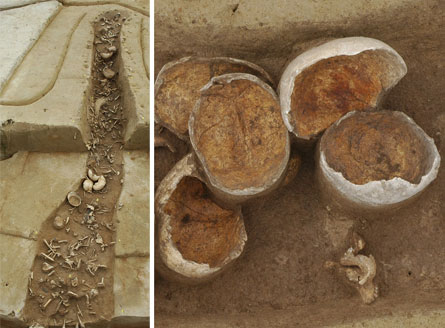

Cannibalism at the village, now called Herxheim, may have occurred during ceremonies in which people from near and far brought slaves, war prisoners or other dependents for ritual sacrifice, propose anthropologist Bruno Boulestin of the University of Bordeaux 1 in France and his colleagues. A social and political crisis in central Europe at that time triggered various forms of violence, the researchers suspect.
“Human sacrifice at Herxheim is a hypothesis that’s difficult to prove right now, but we have evidence that several hundred people were eaten over a brief period,” Boulestin says. Skeletal markings indicate that human bodies were butchered in the same way as animals.
Herxheim offers rare evidence of cannibalism during Europe’s early Neolithic period, when farming first spread, the researchers report in the December Antiquity. Artifacts found at Herxheim come from the Linear Pottery Culture, which flourished in western and central Europe from about 7,500 to 7,000 years ago.
Two archaeologists who have studied human bones unearthed a decade ago at Herxheim reject the new cannibalism hypothesis. In a joint statement to Science News, Jörg Orschiedt of the University of Leipzig in Germany and Miriam Haidle of Senckenberg Research Institute and Natural History Museum in Frankfurt say that Boulestin’s evidence better fits a scenario in which the dead were reburied at Herxheim following dismemberment and removal of flesh from bones. Evidence of ceremonial reburial practices has been reported for many ancient societies.
If further work confirms large-scale cannibalism at Herxheim, “this would be very surprising indeed, simply in terms of the scale involved,” remarks archaeologist Rick Schulting of the University of Oxford in England.
Until now, the only convincing evidence of Neolithic cannibalism came from 6,000-year-old bones in a French cave, Boulestin holds. A 1986 report concluded that the remains of various animals and at least six people were butchered and discarded there. Again, Orschiedt and Haidle say, reburial rather than cannibalism may explain those findings.
Herxheim was first excavated from 1996 to 1999, yielding remains of a large structure, pottery and what appeared to be two parallel ditches encircling the settlement. Closer inspection revealed that the ditches had been formed by overlapping pits that had been dug over several centuries, apparently not exclusively to hold the dead.
Initial excavations of these pits yielded deposits of large numbers of human and dog bones.
Work from 2005 to 2008 — led by Andrea Zeeb-Lanz and Fabian Haack of the archaeology division of Germany’s Directorate General for Cultural Heritage — unearthed additional human bones, mainly skulls and limb bones bearing incisions. Remains of an estimated 500 people have been found so far.
Pottery resting among the bones accumulated over no more than a few decades, the researchers say. Some pieces came from Neolithic sites located 400 kilometers from Herxheim.
The pits that surrounded Herxheim provided no protection from invaders but may have marked a symbolic boundary for a ceremonial settlement, Boulestin proposes. At first, Boulestin’s team, like Orschiedt and Haidle, thought that the dead were brought to Herxheim for ceremonial reburial.
But Boulestin and his colleagues’ opinion changed after they analyzed 217 reassembled human bones from one deposit, representing at least 10 individuals.
Damage typical of animal butchery appears on the bones, including that produced by a technique to separate the ribs from the spine, the scientists say. Heads were skinned and muscles removed from the brain case in order to remove the skullcap. Incisions and scrapes on jaws indicate that tongues were cut out.
Scrape marks inside the broken ends of limb bones indicate that marrow was removed.
People most likely made the chewing marks found near intentionally broken ends of hand and arm bones, Boulestin says.
Ongoing work at Herxheim has found signs of cannibalism on the bones of hundreds of other individuals, with only a few exceptions, he adds.
But proving that ancient Europeans consumed human body parts “is nearly impossible,” Orschiedt and Haidle assert. The absence of lower jaws and skull bases from the new Herxheim material favors a reburial scenario, the researchers say, in which these components were ritually removed before skulls were placed in pits.
Boulestin’s notion of a Neolithic social and political crisis rests on generally accepted evidence of massacres of dozens of people at three central European sites approximately 7,000 years ago. Other regional settlements, including Herxheim, were abandoned around that time.
Planned chemical analyses of bones from Herxheim will indicate whether some individuals grew up eating foods from distant regions, a sign that they were transported to the site. Such evidence would support either a cannibalism or reburial hypothesis.
It’s not yet clear that a widespread crisis actually affected early Neolithic peoples, comments archaeologist Nick Thorpe of the University of Winchester in England.
Whatever actually happened at Herxheim, facial bones were smashed beyond recognition, “giving an impression of the destruction of individual identity, a kind of psychic violence against the person,” Thorpe says.


